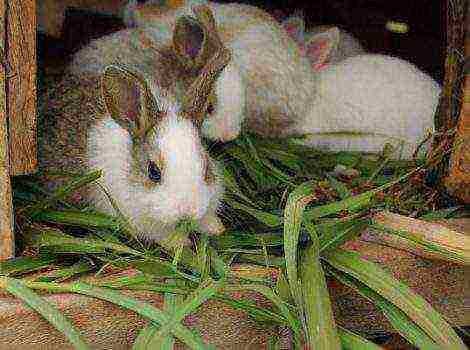The danger of African swine fever for humans
African swine fever (ASF) is recognized as one of the most serious and dangerous infectious diseases. The death rate among wild and domestic animals is very high. The virus affects all livestock, regardless of the age and quality of piglets... The good news is that ASF is not transmitted to humans, but it causes a great loss to agriculture, because they have not yet developed a serum for the treatment of this disease. In this article, you will learn about the symptoms of this disease and how to prevent it.
African swine fever
African swine fever is an infectious animal disease. Source of disease - the DNA that contains the virus. It belongs to a separate category. There are A and B types of this virus, as well as subspecies C. It is resistant to temperature changes, does not lend itself to freezing, decay and drying.
ASF came to us from South Africa... The first signs of the appearance of pathology were recorded in 1903. After that, the virus appeared in Portugal and Spain, and from there in Central and South America. Today, the likelihood of contracting the plague is in any part of the world.
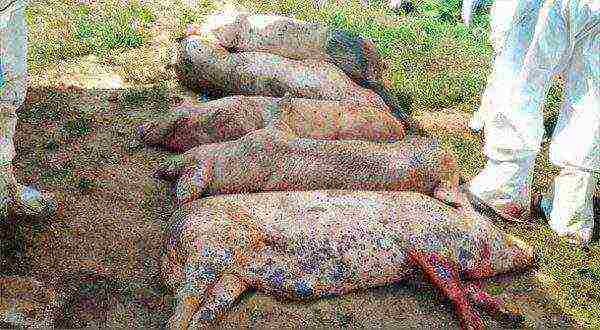
Infected or recovered pigs are carriers of the infectionthat carry the pathogen up to 18 months.
Infection enters the body through damaged mucous membranes, skin, blood, insect bites, with contaminated food and alimentary. With the appearance of the first signs, about 37% of the population becomes victims of the disease. This disease is dangerous, regardless of the place where the animal is kept.
First symptoms and signs
Incubation period lasts 1-2 weeks. Therefore, it is not always possible to make a diagnosis immediately and correctly. Depending on the degree of the disease, different signs appear:
- high temperature (above 40 ° C);
- lack of appetite;
- manifestation of apathy;
- hindered breath;

- excretion from the nose and eyes;
- in some cases - molt;
- harsh, unreasonable case;
- impaired motility;
- malfunction of the gastrointestinal tract;
- bruising, subcutaneous edema;
- variable fever;
- pneumonia;
Due to the variability of symptoms (virus mutation), they may not appear in all animals.
Chronic and atypical form of the disease
Depending on the degree of infection, distinguish between chronic and atypical forms of the disease.
Chronic plague can last up to two months or more. Pigs suffer from recurrent diarrhea, fever attacks, impaired appetite, pneumonia. Animals lose weight, the skin wrinkles, bruises appear on the ears, tail and limbs. With this form of the disease, clinical signs can vary greatly. All cases of infection end in the form of a lethal animal.... The virus is not cleared from the body, and these pigs remain carriers of the virus.
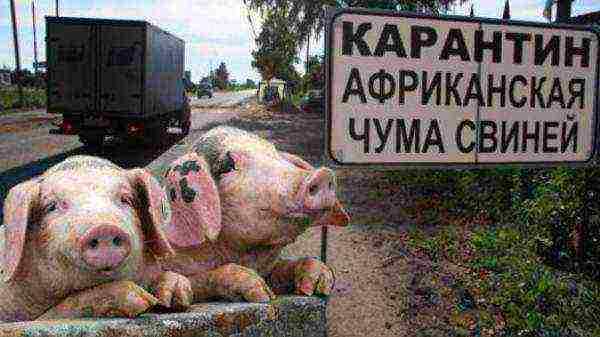
Atypical form of the American virus It is often diagnosed in suckling pigs and weaners who have maternal immunity, or they are infected with a weakly virulent virus of serogroup B. In the early stages of the disease, plague is clinically manifested by refusal to eat, conjunctivitis, and bruising. Some piglets recover completely, while the rest develop complications with secondary bacterial viruses.Because of this, massive pneumonia and gastroenterocolitis appear, which ends with the death of the animal within three days. Infected pigs do not fully recover and remain carriers of the disease for a long time. Mortality in such cases it is 30 - 60%.
ASF diagnostics
Without laboratory tests, it is impossible to establish an accurate diagnosis of African plague. Diagnosis is carried out on the basis of pathological and epizootological data., clinical symptoms and laboratory test results. For this, a blood sample is taken from sick animals, and organ fragments are taken from corpses.
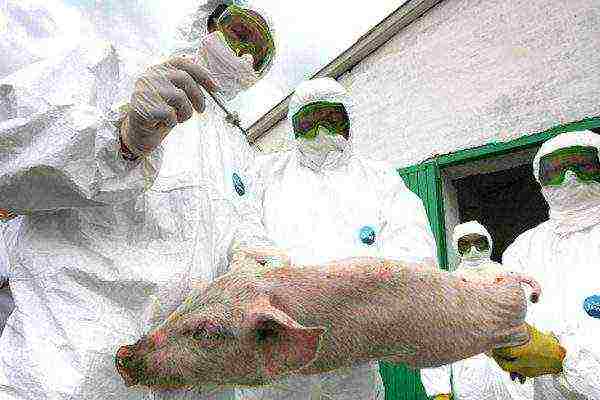
Delivery of spleen particles from more animals is carried out if the virus can be isolated and pathology established. The biomaterial is transferred in a high-quality form and delivered in a short time. Therefore, each particle is placed in an individual bag and then in a container with ice. Fragments must not freezeme, simple cooling is enough.
Blood sample for serological enzyme-linked immunosorbent assays (ELISA) should be taken from animals that are sick for a long time or have been in contact with infected piglets, and with suspicion of infection with the plague virus.
Virus treatment, quarantine
To date, no drugs have been developed to combat this disease, and African swine fever is considered fatal... During the first period of infection, which has raised suspicions of ASF, some pig farms provide emergency vaccinations for all animals. Such measures allow to save some of the infected pigs. Livestock technology, all livestock are slaughtered in an isolated area with the subsequent incineration of corpses. Some home-based pig farms are practicing an effective means of controlling ASF in the early stages. The animal is poured into the mouth of 100 - 150 g of vodka. In most cases, the pig will recover.
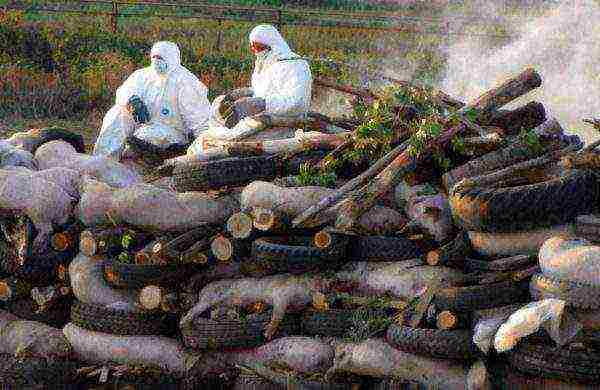
Classic methods of disease prevention
For that, to prevent infection pig farm, both with classical distemper and ASF, should adhere to these rules:
- to purchase feed in places where there are no viral infections. Heat treatment before feeding;
- systematically to disinfect the farm and feed warehousesas well as treatment against various parasites;
- prevent pigs from coming into contact with animals from other farms, domestic animals and carnivorous birds that are carriers of infection;
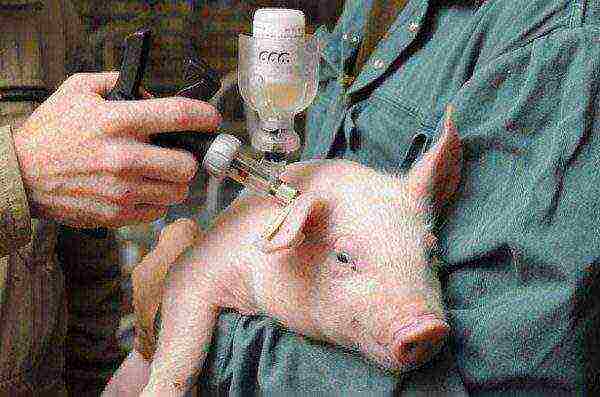
- do not bring non-disinfected equipment to the pig farm, as well as transport from the contaminated area that has not been processed;
- purchase pigs only with veterinary documents, which confirm the data on the health of the animal. Introduced piglets should be isolated before entering the common pen;
- regularly vaccinate against major diseases, do not forget to carry out veterinary examinations. Carry out slaughter of animals in specialized places.
Is African swine fever dangerous for people and can such meat be eaten?
If you ask the question: "Is it worth fearing this disease for a person?", Then it is very difficult to get an exact answer. For people, this disease does not pose a particular danger.... More precisely, no cases of human infection have been recorded. The products of diseased animals can be used in cooking only after prolonged heat treatment (you can boil and fry meat, but smoking does not kill viruses).But if you think about it, there is still a risk of infection. This is a disease, and it has not yet been fully understood. A few examples of this:
- ASF virus is not dangerous to humans, but any infection weakens the defense reaction of any organism. There have been cases of detection of antibodies against plague in the human body, which means the likelihood that people can tolerate this pathology without symptoms.
- This the infection develops unexpectedly, being a single representative in the class of asfaviruses. The virus mutates, which can lead to an increase in its species. There is a risk that a person can become infected with it.
- There is evidence that the virus has been detected in people suffering from tropical fever... This infection can accompany the development of various serious illnesses.
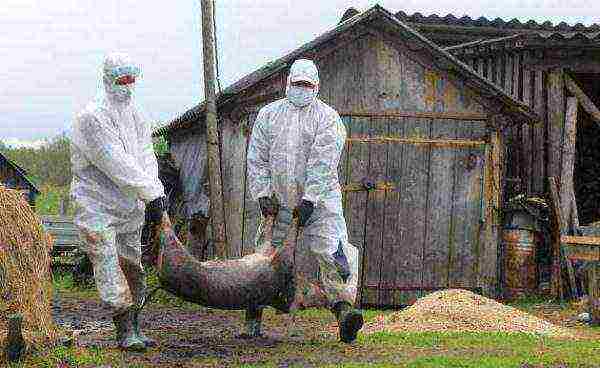
It can be concluded that African swine fever does not pose a huge danger to humans, but for safety, contact with infected pigs must be avoided.
African swine fever is fatal. It is caused by the special vitality of the virus, which, when it enters the pig's body, begins to multiply rapidly. It instantly affects animals within a radius of up to 10 km. Therefore, in most countries, at the government level, actions to prevent and control African swine fever infection, as well as an educational program about what can be and how to recognize the signs of African swine fever in time.


